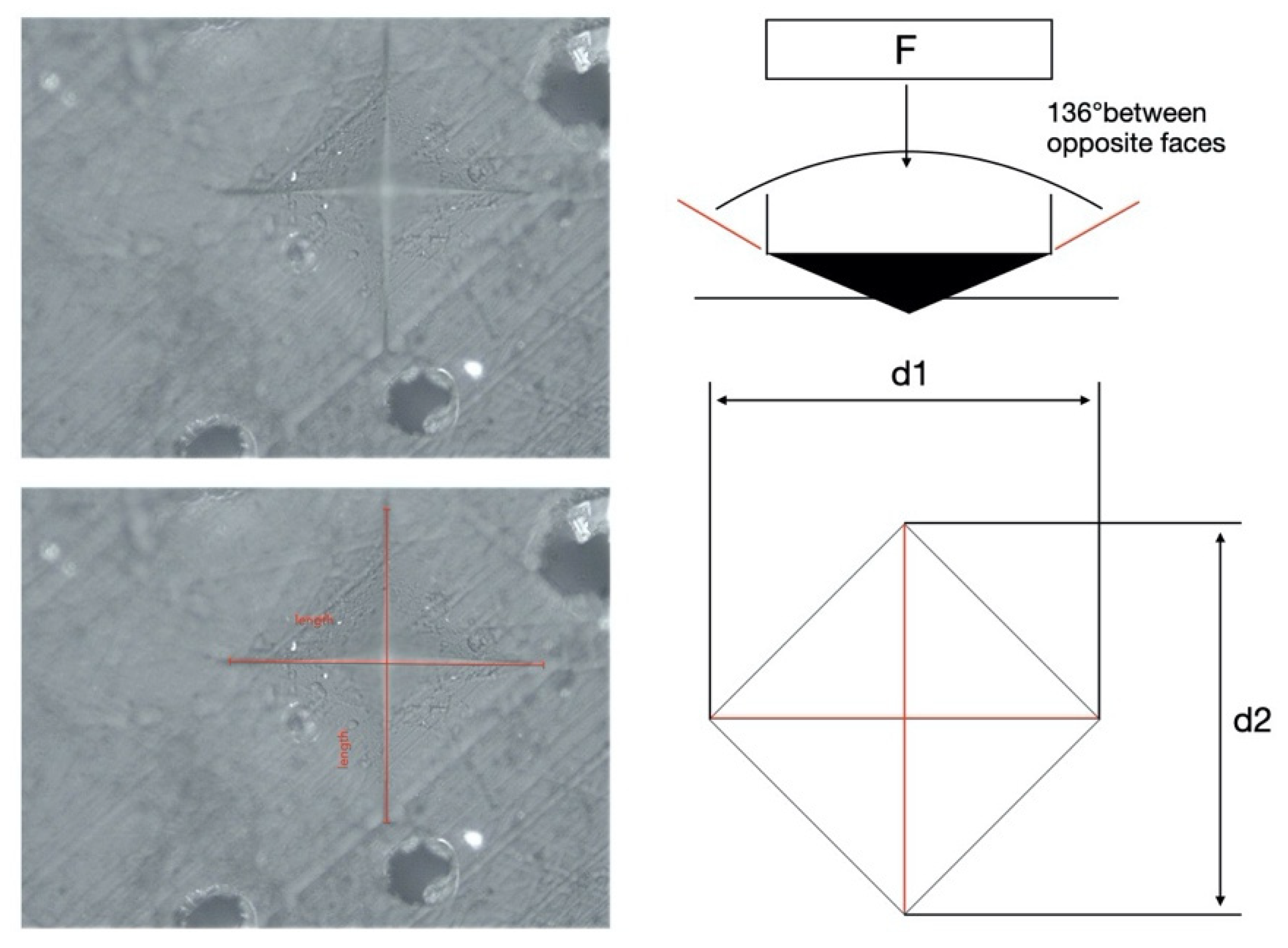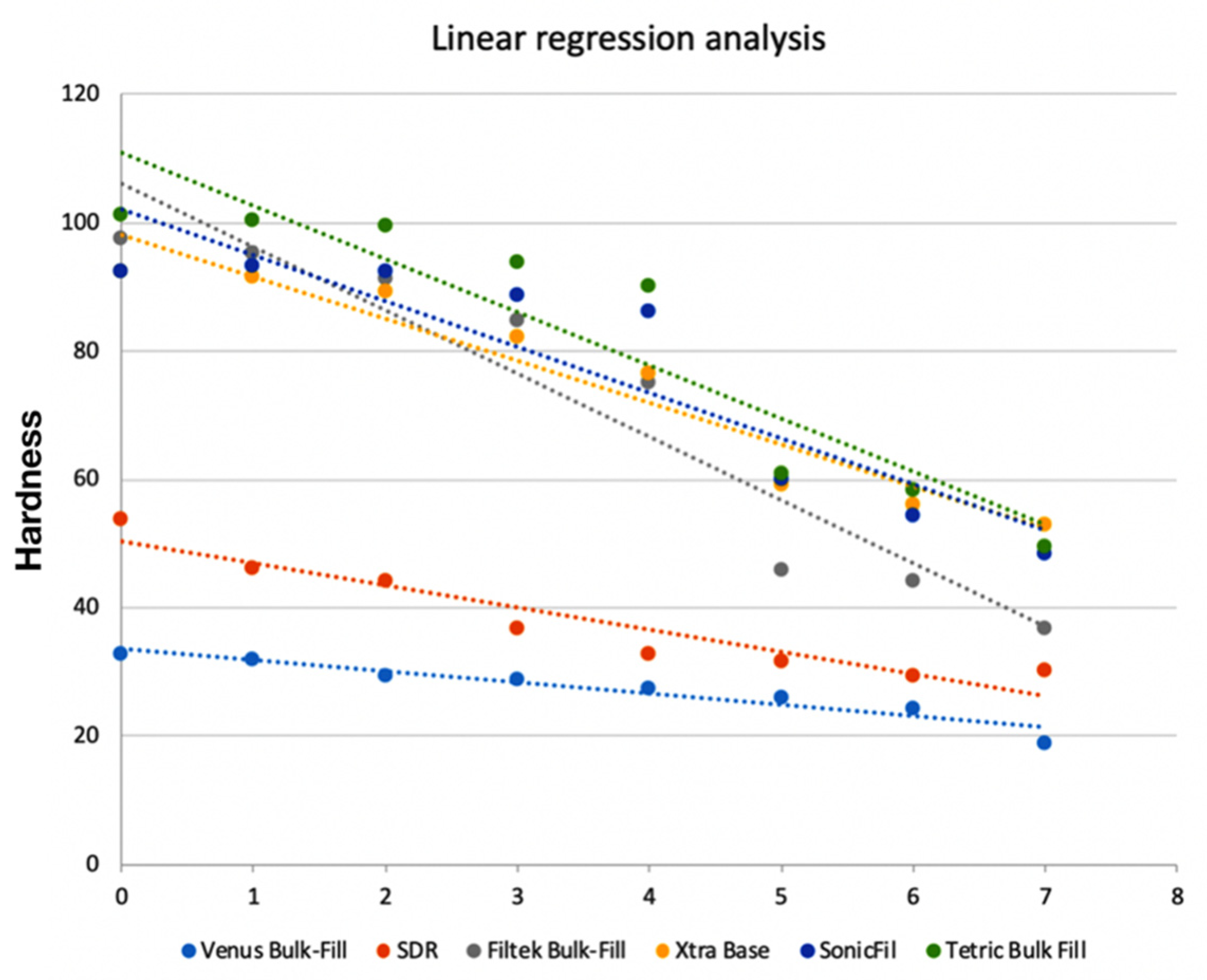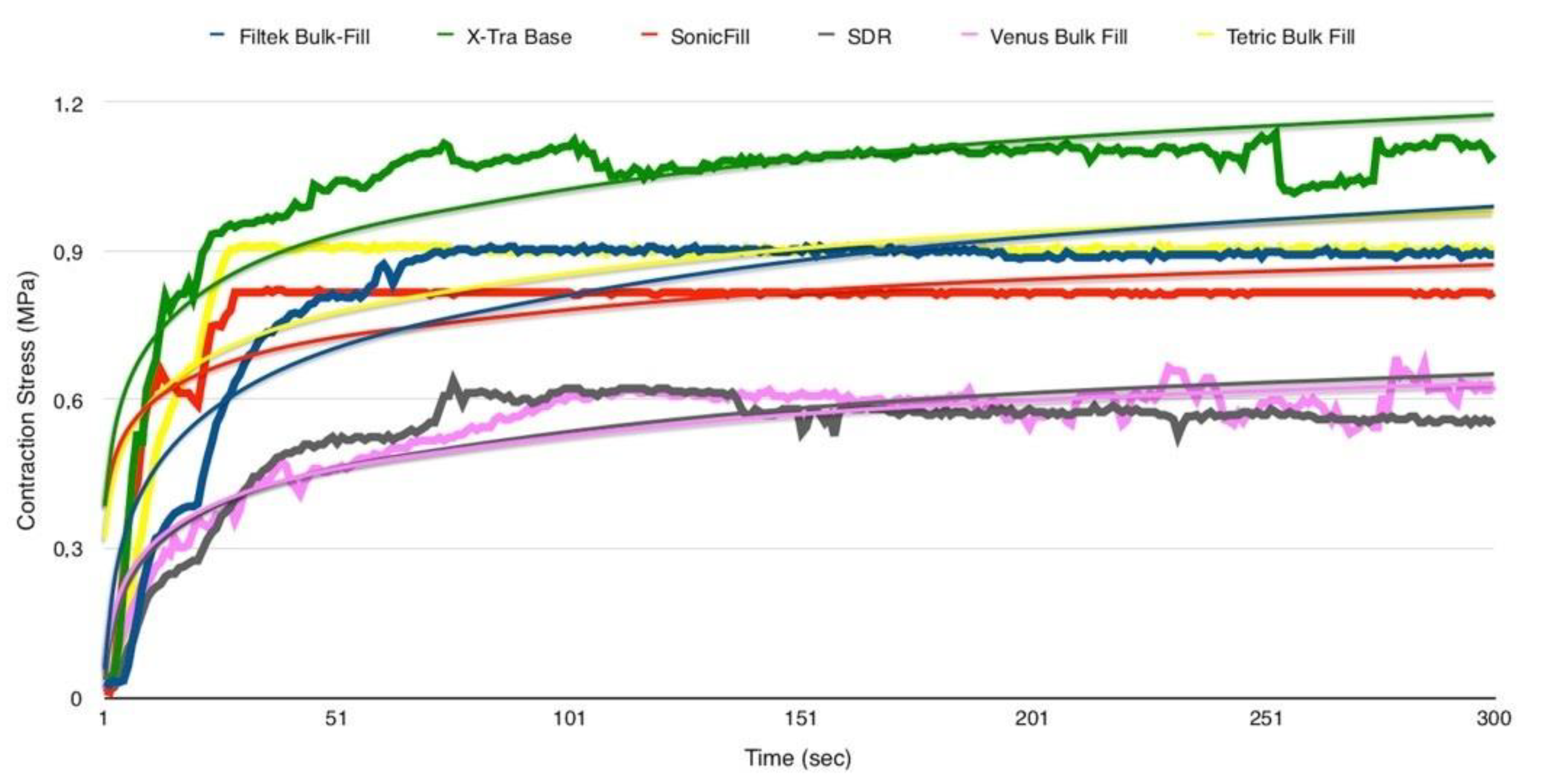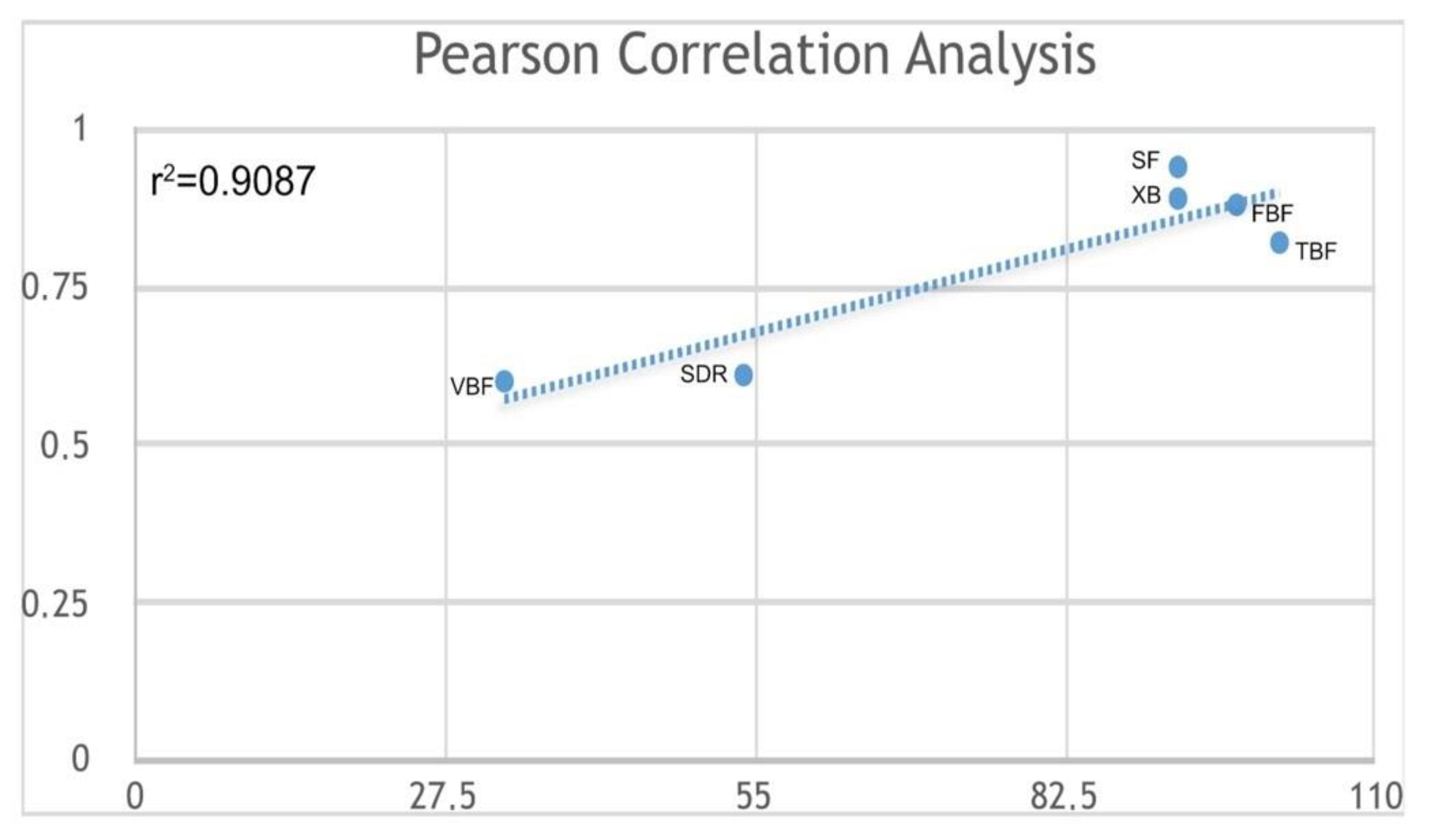Vickers Hardness and Shrinkage Stress Evaluation of Low and High Viscosity Bulk-Fill Resin Composite
Abstract
1. Introduction
2. Materials and Methods
2.1. Hardness Evaluation
2.2. Shrinkage Stress Evaluation
2.3. Statistical Analysis
3. Results
3.1. Microhardness
3.2. Shrinkage Stress
4. Discussion
5. Conclusions
Author Contributions
Funding
Conflicts of Interest
References
- Kwon, Y.; Ferracane, J.; Lee, I.B. Effect of layering methods, composite type, and flowable liner on the polymerization shrinkage stress of light cured composites. Dent. Mater. 2012, 28, 801–809. [Google Scholar] [CrossRef]
- van Dijken, J.W. Durability of resin composite restorations in high C-factor cavities: A 12-year follow-up. J. Dent. 2010, 38, 469–474. [Google Scholar] [CrossRef]
- Krämer, N.; Lohbauer, U.; García-Godoy, F.; Frankenberger, R. Light curing of resin-based composites in the LED era. Am. J. Dent. 2008, 21, 135–142. [Google Scholar]
- Chen, H.Y.; Manhart, J.; Hickel, R.; Kunzelmann, K.H. Polymerization contraction stress in light-cured packable composite resins. Dent. Mater. 2001, 17, 253–259. [Google Scholar] [CrossRef]
- Braga, R.R.; Ballester, R.Y.; Ferracane, J.L. Factors involved in the development of polymerization shrinkage stress in resin-composites: A systematic review. Dent. Mater. 2005, 21, 962–970. [Google Scholar] [CrossRef] [PubMed]
- Kim, M.E.; Park, S.H. Comparison of premolar cuspal deflection in bulk or in incremental composite restoration methods. Oper. Dent. 2011, 36, 326–334. [Google Scholar] [CrossRef]
- van Dijken, J.W.; Pallesen, U. A randomized 10-year prospective follow-up of Class II nanohybrid and conventional hybrid resin composite restorations. J. Adhes Dent. 2014, 16, 585–592. [Google Scholar] [CrossRef]
- Czasch, P.; Ilie, N. In vitro comparison of mechanical properties and degree of cure of bulk fill composites. Clin. Oral Investig. 2013, 17, 227–235. [Google Scholar] [CrossRef] [PubMed]
- Ilie, N.; Rencz, A.; Hickel, R. Investigations towards nano-hybrid resin-based composites. Clin. Oral Investig. 2013, 17, 185–193. [Google Scholar] [CrossRef]
- van Dijken, J.W.; Pallesen, U. Posterior bulk-filled resin composite restorations: A 5-year randomized controlled clinical study. J. Dent. 2016, 51, 29–35. [Google Scholar] [CrossRef]
- Zorzin, J.; Maier, E.; Harre, S.; Fey, T.; Belli, R.; Lohbauer, U.; Petschelt, A.; Taschner, M. Bulk-fill resin composites: Polymerization properties and extended light curing. Dent. Mater. 2015, 31, 293–301. [Google Scholar] [CrossRef] [PubMed]
- Moorthy, A.; Hogg, C.H.; Dowling, A.H.; Grufferty, B.F.; Benetti, A.R.; Fleming, G.J. Cuspal deflection and microleakage in premolar teeth restored with bulk-fill flowable resin-based composite base materials. J. Dent. 2012, 40, 500–505. [Google Scholar] [CrossRef] [PubMed]
- Ilie, N.; Hickel, R. Investigations on a methacrylate-based flowable composite based on the SDR™ technology. Dent. Mater. 2011, 27, 348–355. [Google Scholar] [CrossRef]
- Ilie, N.; Bucuta, S.; Draenert, M. Bulk-fill resin-based composites: An in vitro assessment of their mechanical performance. Oper. Dent. 2013, 38, 618–625. [Google Scholar] [CrossRef]
- Jung, J.H.; Park, S.H. Comparison of Polymerization Shrinkage, Physical Properties, and Marginal Adaptation of Flowable and Restorative Bulk Fill Resin-Based Composites. Oper. Dent. 2017, 42, 375–386. [Google Scholar] [CrossRef] [PubMed]
- Furness, A.; Tadros, M.Y.; Looney, S.W.; Rueggeberg, F.A. Effect of bulk/incremental fill on internal gap formation of bulk-fill composites. J. Dent. 2014, 42, 439–449. [Google Scholar] [CrossRef] [PubMed]
- Scougall-Vilchis, R.J.; Hotta, Y.; Hotta, M.; Idono, T.; Yamamoto, K. Examination of composite resins with electron microscopy, microhardness tester and energy dispersive X-ray microanalyzer. Dent. Mater. J. 2009, 28, 102–112. [Google Scholar] [CrossRef]
- El-Safty, S.; Akhtar, R.; Silikas, N.; Watts, D.C. Nanomechanical properties of dental resin-composites. Dent. Mater. 2012, 28, 1292–1300. [Google Scholar] [CrossRef]
- Taylor, D.F.; Kalachandra, S.; Sankarapandian, M.; McGrath, J.E. Relationship between filler and matrix resin characteristics and the properties of uncured composite pastes. Biomaterials 1998, 19, 197–204. [Google Scholar] [CrossRef]
- Obici, A.C.; Sinhoreti, M.A.; Correr Sobrinho, L.; de Goes, M.F.; Consani, S. Evaluation of depth of cure and Knoop hardness in a dental composite photo-activated using different methods. Braz. Dent. J. 2004, 15, 199–203. [Google Scholar] [CrossRef]
- de Araújo, C.S.; Schein, M.T.; Zanchi, C.H.; Rodrigues, S.A., Jr.; Demarco, F.F. Composite resin microhardness: The influence of light curing method, composite shade, and depth of cure. J. Contemp. Dent. Pract. 2008, 9, 43–50. [Google Scholar]
- Bouschlicher, M.R.; Rueggeberg, F.A.; Wilson, B.M. Correlation of bottom-to-top surface microhardness and conversion ratios for a variety of resin composite compositions. Oper. Dent. 2004, 29, 698–704. [Google Scholar] [PubMed]
- Watts, D.C. Reaction kinetics and mechanics in photo-polymerised networks. Dent. Mater. 2005, 21, 27–35. [Google Scholar] [CrossRef] [PubMed]
- Frassetto, A.; Navarra, C.O.; Marchesi, G.; Turco, G.; Di Lenarda, R.; Breschi, L.; Ferracane, J.L.; Cadenaro, M. Kinetics of polymerization and contraction stress development in self-adhesive resin cements. Dent. Mater. 2012, 28, 1032–1039. [Google Scholar] [CrossRef] [PubMed]
- Bucuta, S.; Ilie, N. Light transmittance and micro-mechanical properties of bulk fill vs. conventional resin based composites. Clin. Oral Invest. 2014, 18, 1991–2000. [Google Scholar] [CrossRef] [PubMed]
- Leprince, J.G.; Palin, W.M.; Vanacker, J.; Sabbagh, J.; Devaux, J.; Leloup, G. Physico-mechanical characteristics of commercially available bulk-fill composites. J. Dent. 2014, 42, 993–1000. [Google Scholar] [CrossRef]
- Rodriguez, A.; Yaman, P.; Dennison, J.; Garcia, D. Effect of Light-Curing Exposure Time, Shade, and Thickness on the Depth of Cure of Bulk Fill Composites. Oper. Dent. 2017, 42, 505–513. [Google Scholar] [CrossRef]
- Par, M.; Gamulin, O.; Marovic, D.; Klaric, E.; Tarle, Z. Effect of temperature on post-cure polymerization of bulk-fill composites. J. Dent. 2014, 42, 1255–1260. [Google Scholar] [CrossRef]
- Alrahlah, A.; Silikas, N.; Watts, D.C. Post-cure depth of cure of bulk fill dental resin-composites. Dent. Mater. 2014, 30, 149–154. [Google Scholar] [CrossRef] [PubMed]
- Li, J.; Li, H.; Fok, A.S.; Watts, D.C. Multiple correlations of material parameters of light-cured dental composites. Dent. Mater. 2009, 25, 829–836. [Google Scholar] [CrossRef]
- Tsai, P.C.; Meyers, I.A.; Walsh, L.J. Depth of cure and surface microhardness of composite resin cured with blue LED curing lights. Dent. Mater. 2004, 20, 364–369. [Google Scholar] [CrossRef]
- Flury, S.; Hayoz, S.; Peutzfeldt, A.; Hüsler, J.; Lussi, A. Depth of cure of resin composites: Is the ISO 4049 method suitable for bulk fill materials? Dent. Mater. 2012, 28, 521–528. [Google Scholar] [CrossRef] [PubMed]
- Leprince, J.G.; Leveque, P.; Nysten, B.; Gallez, B.; Devaux, J.; Leloup, G. New insight into the "depth of cure" of dimethacrylate-based dental composites. Dent. Mater. 2012, 28, 512–520. [Google Scholar] [CrossRef] [PubMed]
- Musanje, L.; Darvell, B.W. Curing-Light Attenuation in Filled-Resin Restorative Materials. Dent. Mater. 2006, 22, 804–817. [Google Scholar] [CrossRef] [PubMed]
- Leloup, G.; Holvoet, P.E.; Bebelman, S.; Devaux, J. Raman Scattering Determination of the Depth of Cure of Light-Activated Composites: Influence of Different Clinically Relevant Parameters. J. Oral Rehabil. 2002, 29, 510–515. [Google Scholar] [CrossRef] [PubMed]
- Davidson-Kaban, S.S.; Davidson, C.L.; Feilzer, A.J.; de Gee, A.J.; Erdilek, N. The effect of curing light variations on bulk curing and wall-to-wall quality of two types and various shades of resin composites. Dent. Mater. 1997, 13, 344–352. [Google Scholar] [CrossRef]
- Unterbrink, G.L.; Muessner, R. Influence of Light Intensity on Two Restorative Systems. J. Dent. 1995, 23, 183–189. [Google Scholar] [CrossRef]
- Shortall, A.C. How light source and product shade influence cure depth for a contemporary composite. J. Oral Rehabil. 2005, 32, 906–911. [Google Scholar] [CrossRef]
- Felix, C.A.; Price, R.B.; Andreou, P. Effect of reduced exposure times on the microhardness of 10 resin composites cured by high-power LED and QTH curing lights. J. Can. Dent. Assoc. 2006, 72, 147. [Google Scholar]
- Ferracane, J.L.; Greener, E.H. Fourier transform infrared analysis of degree of polymerization in unfilled resins--methods comparison. J. Dent. Res. 1984, 63, 1093–1095. [Google Scholar] [CrossRef]
- Hadis, M.A.; Shortall, A.C.; Palin, W.M. Specimen Aspect Ratio and Light Transmission in Photoactive Dental Resins. Dent. Mater. 2012, 28, 1154–1161. [Google Scholar] [CrossRef] [PubMed]
- Yoon, T.H.; Lee, Y.K.; Lim, B.S.; Kim, C.W. Degree of polymerization of resin composites by different light sources. J. Oral Rehabil. 2002, 29, 1165–1173. [Google Scholar] [CrossRef] [PubMed]
- AlQahtani, M.Q.; Michaud, P.L.; Sullivan, B.; Labrie, D.; AlShaafi, M.M.; Price, R.B. Effect of High Irradiance on Depth of Cure of a Conventional and a Bulk Fill Resin-based Composite. Oper. Dent. 2015, 40, 662–672. [Google Scholar] [CrossRef] [PubMed]
- Ilie, N.; Stark, K. Curing behaviour of high-viscosity bulk-fill composites. J. Dent. 2014, 42, 977–985. [Google Scholar] [CrossRef] [PubMed]
- Kumar, N.; Fareed, M.A.; Zafar, M.S.; Ghani, F.; Khurshid, Z. Influence of various specimen storage strategies on dental resin-based composite properties. Mater. Tech. 2020, 13, 1–9. [Google Scholar] [CrossRef]
- El-Damanhoury, H.; Platt, J. Polymerization shrinkage stress kinetics and related properties of bulk-fill resin composites. Oper Dent. 2014, 39, 374–382. [Google Scholar] [CrossRef]
- Finan, L.; Palin, W.M.; Moskwa, N.; McGinley, E.L.; Fleming, G. The Influence of Irradiation Potential on the Degree of Conversion and Mechanical Properties of Two Bulk-Fill Flowable RBC Base Materials. Dent. Mater. 2013, 29, 906–912. [Google Scholar] [CrossRef]
- Ilie, N.; Keßler, A.; Durner, J. Influence of various irradiation processes on the mechanical properties and polymerisation kinetics of bulk-fill resin based composites. J. Dent. 2013, 41, 695–702. [Google Scholar] [CrossRef]
- Spinell, T.; Schedle, A.; Watts, D.C. Polymerization shrinkage kinetics of dimethacrylate resin-cements. Dent. Mater. 2009, 25, 1058–1066. [Google Scholar] [CrossRef]
- Burgess, J.; Cakir, D. Comparative properties of low-shrinkage composite resins. Compend. Contin. Educ. Dent. 2010, 31, 10–15. [Google Scholar]
- Braem, M.; Finger, W.; Van Doren, V.E.; Lambrechts, P.; Vanherle, G. Mechanical properties and filler fraction of dental composites. Dent. Mater. 1989, 5, 346–348. [Google Scholar] [CrossRef]
- Gonçalves, F.; Kawano, Y.; Braga, R.R. Contraction stress related to composite inorganic content. Dent. Mater. 2010, 26, 704–709. [Google Scholar] [CrossRef]
- Baroudi, K.; Saleh, A.M.; Silikas, N.; Watts, D.C. Shrinkage behaviour of flowable resin-composites related to conversion and filler-fraction. J. Dent. 2007, 35, 651–655. [Google Scholar] [CrossRef]
- Satterthwaite, J.D.; Maisuria, A.; Vogel, K.; Watts, D.C. Effect of resin-composite filler particle size and shape on shrinkage-stress. Dent. Mater. 2012, 28, 609–614. [Google Scholar] [CrossRef]
- Condon, J.R.; Ferracane, J.L. Assessing the effect of composite formulation on polymerization stress. J. Am. Dent. Assoc. 2000, 131, 497–503. [Google Scholar] [CrossRef] [PubMed]
- Kleverlaan, C.J.; Feilzer, A.J. Polymerization shrinkage and contraction stress of dental resin composites. Dent. Mater. 2005, 21, 1150–1157. [Google Scholar] [CrossRef] [PubMed]
- Marchesi, G.; Breschi, L.; Antoniolli, F.; Di Lenarda, R.; Ferracane, J.; Cadenaro, M. Contraction stress of low-shrinkage composite materials assessed with different testing systems. Dent. Mater. 2010, 26, 947–953. [Google Scholar] [CrossRef] [PubMed]
- Haak, R.; Wicht, M.J.; Noack, M.J. Marginal and internal adaptation of extended class I restorations lined with flowable composites. J. Dent. 2003, 31, 231–239. [Google Scholar] [CrossRef]
- Braem, M.; Lambrechts, P.; Vanherle, G.; Davidson, C.L. Stiffness increase during the setting of dental composite resins. J. Dent. Res. 1987, 66, 1713–1716. [Google Scholar] [CrossRef]
- Vaidyanathan, J.; Vaidyanathan, T.K. Flexural creep deformation and recovery in dental composites. J. Dent. 2001, 29, 545–551. [Google Scholar] [CrossRef]
- Lim, B.S.; Ferracane, J.L.; Sakaguchi, R.L.; Condon, J.R. Reduction of polymerization contraction stress for dental composites by two-step light-activation. Dent. Mater. 2002, 18, 436–444. [Google Scholar] [CrossRef]
- Michaud, P.L.; Price, R.B.; Labrie, D.; Rueggeberg, F.A.; Sullivan, B. Localised irradiance distribution found in dental light curing units. J. Dent. 2014, 42, 129–139. [Google Scholar] [CrossRef] [PubMed]





| Composite | Manufacturer | Type | Resin Matrix | Filler | Filler w%; v% |
|---|---|---|---|---|---|
| Tetric Evoceram Bulk Fill | Ivoclar Vivadent, Schaan, Liechtenstein | Nano-hybrid, high viscosity | Bis-GMA, UDMA | Ba-Al-Si-glass, prepolymer filler (monomer, glass filler and ytterbium fluoride). Spherical mixed oxide | 79–81 (including 17% prepolymers); 60–61 |
| SureFil SDR | Dentsply De Trey, Konstanz, Germany | Low viscosity | Modified UDMA, TEGDMA, EBPDMA | Ba-Al-F-B-Si glass and St-Al-F-Si glass as fillers | 68; 44 |
| X-tra Base | VOCO, Cuxhaven, Germany | Hybrid, low viscosity | Bis-GMA, UDMA | 2-3 μm Ba B Al Si glass filler | 75; 60 |
| SonicFill | Kerr Corp. California USA | Nano-hybrid, high viscosity | Bis-GMA, TEGDMA, EBPDMA | SiO2, glass, oxide | 83.5; 66 |
| Filtek Bulk Fill | 3M ESPE, St Paul, MN, USA | Nano-hybrid, low viscosity | Bis-GMA, UDMA, Bis-EMA, Procrylat resins | Zirconia/silica, ytterbium trifluoride | 64.5; 42.5 |
| Venus Bulk Fill | Heraeus Kulzer, Hanau, Germany | Nano-hybrid, low viscosity | multifunctional methacrylate monomers (UDMA, EBPDMA) | Ba-Al-F silicate glass, YbF3, SiO2 | 65; 38 |
| Material | ||||||
|---|---|---|---|---|---|---|
| Venus Bulk Fill | SDR | Filtek Bulk Fill | Xtra Base | SonicFil | Tetric Bulk Fill | |
| Top | 32.8 ± 3.4 a | 54.0 ± 6.6 a | 97.7 ± 4.9 a | 91.5 ± 4.8 a | 92.5 ± 4.8 a | 101.5 ± 4.8 a |
| 1 mm | 32.1 ± 6.1 a | 46.2 ± 6.1 a | 95.3 ± 3.3 a | 91.5 ± 3.7 a | 93.5 ± 4.8 a | 100.6 ± 6.4 a |
| 2 mm | 29.4 ± 6.1 a | 44.2 ± 6.2 b | 91.5 ± 4.5 a | 89.5 ± 4.6 a | 92.5 ± 5.5 a | 99.7 ± 6.5 a |
| 3 mm | 28.9 ± 5.4 a | 36.9 ± 6.4 b | 84.9 ± 7.8 b | 82.3 ± 2.6 b | 88.8 ± 7.1 a | 94.1 ± 6 a |
| 4 mm | 27.4 ± 5.1 a | 33.0 ± 5.5 b | 75.1 ± 8.5 b | 76.7 ± 2.6 b | 86.2 ± 6.4 b | 90.2 ± 6.7 b |
| 5 mm | 26.1 ± 3.5 b | 31.7 ± 4.7 b | 45.9 ± 8.5 b | 59.4 ± 5.4 b | 60.1 ± 4.7 b | 60.9 ± 8.3 b |
| 6 mm | 24.4 ± 4.9 b | 29.5 ± 5.1 b | 44.3 ± 7.5 b | 56.3 ± 3.7 b | 54.6 ± 4.2 b | 58.6 ± 9.1 b |
| Bottom | 19.1 ± 3.4 b | 30.4 ± 4.5 b | 36.9 ± 9 b | 53.0 ± 6.2 b | 48.4 ± 6.5 b | 49.7 ± 6.6 b |
| Venus Bulk Fill | SDR | Filtek Bulk Fill | Xtra Base | SonicFil | Tetric Bulk Fill | |
|---|---|---|---|---|---|---|
| 80% Top (VHN) | 26.2 | 43.1 | 78.1 | 74.0 | 74.0 | 81.2 |
| 80% Top (mm) | 4.92 | 2.15 | 3.69 | 4.16 | 4.47 | 4.31 |
| Material | Contraction Stress (MPa) | t-Max (sec) |
|---|---|---|
| Venus Bulk | 0.60 ± 0.03 a | 87.23 ± 2.76 |
| SDR | 0.61 ± 0.05 a | 77.12 ± 2.56 |
| Filtek Bulk | 0.88 ± 0.04 b | 73.34 ± 2.36 |
| X-tra Base | 0.89 ± 0.05 b | 75.08 ± 2.78 |
| Sonicfil | 0.94 ± 0.05 b | 30.29 ± 2.02 |
| Tetric Bulk | 0.82 ± 0.07 b | 29.43 ± 1.93 |
© 2020 by the authors. Licensee MDPI, Basel, Switzerland. This article is an open access article distributed under the terms and conditions of the Creative Commons Attribution (CC BY) license (http://creativecommons.org/licenses/by/4.0/).
Share and Cite
Comba, A.; Scotti, N.; Maravić, T.; Mazzoni, A.; Carossa, M.; Breschi, L.; Cadenaro, M. Vickers Hardness and Shrinkage Stress Evaluation of Low and High Viscosity Bulk-Fill Resin Composite. Polymers 2020, 12, 1477. https://doi.org/10.3390/polym12071477
Comba A, Scotti N, Maravić T, Mazzoni A, Carossa M, Breschi L, Cadenaro M. Vickers Hardness and Shrinkage Stress Evaluation of Low and High Viscosity Bulk-Fill Resin Composite. Polymers. 2020; 12(7):1477. https://doi.org/10.3390/polym12071477
Chicago/Turabian StyleComba, Allegra, Nicola Scotti, Tatjana Maravić, Annalisa Mazzoni, Massimo Carossa, Lorenzo Breschi, and Milena Cadenaro. 2020. "Vickers Hardness and Shrinkage Stress Evaluation of Low and High Viscosity Bulk-Fill Resin Composite" Polymers 12, no. 7: 1477. https://doi.org/10.3390/polym12071477
APA StyleComba, A., Scotti, N., Maravić, T., Mazzoni, A., Carossa, M., Breschi, L., & Cadenaro, M. (2020). Vickers Hardness and Shrinkage Stress Evaluation of Low and High Viscosity Bulk-Fill Resin Composite. Polymers, 12(7), 1477. https://doi.org/10.3390/polym12071477












